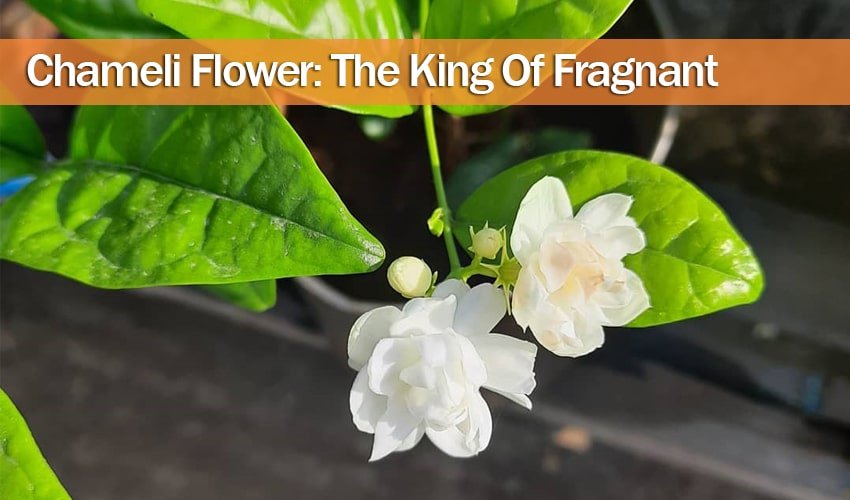Do you want a plant with flower and fragrant? the Chameli plant is best for your house.
Jasmine(Chameli) flower is known as the most beautiful and fragrant flower in Asia. Chameli is a small flower with tiny five petals and is a box of fragrance. This flower has a positive outcome on the happiness and positivity of an individual.
Your Garden increases connectivity with friends, family and relatives. This flower is also known as, Jui, Chameli, Arabian Jasmine, Jai Sayali, Madanban or Mallika Kunda. This is a favorite Flower of Lord Vishnu and Lakshmi.
Plants that wake when others sleep. Timid jasmine buds that keep their fragrance to themselves all day, but when the sunlight dies away let the delicious secret out to every breeze that roams about.
(By-Thomas Moore )
What is a Jasmine flower?

Jasmine (chameli) flower is a genus of vines and bush in the Oleaceae family. Jasmines are widely cultivated for the characteristic fragrance of their flowers .
It contains around 200 species native to warm and tropical temperate regions of Oceania and Eurasia. Any of numerous often climbing bush of the olive family that usually have extremely fragrant flowers.
Chameli flower is called perfumery flower…
History of this beautiful flower
The word Jasmine has been concluding from the Arabic word “yasmin,” which means fragrant flower. Some botanists have been believed that Persia( now Iran) is a place where Jasmine originated.
It crossed the Red Sea into Egypt as before as 1000 B.C., and some botanists also believe that the Chameli flower may have hailed from the Himalayas mountain, which is west part of China and Tibet. Before 1280 BC, The Emperors of the sung dynasty in China have enjoyed the smell of jasmine flowers.
Chameli has most white or yellow star-shaped flowers that grow on shrubbery. Chameli belongs to the olive or Oleaceae family.
Scientific classification of Chameli
Jasmine (taxonomic name Jasminum YASS-min-əm) has been a genus of bush and vines in the olive family (Oleaceae). It has contained around 200 species.
Jasmine’s common names are confederate Jasmine, confederate jessamine, southern Jasmine, star jasmine, and Chinese star jasmine. Jasminum is commonly known as the common Jasmine or simply Jasmine.
What we need before growing chameli or what makes it special
Fertilize Jasmine twice a year with fertilizer that is rich in phosphorus and potassium. Chameli plants like much water; therefore, the soil takes always be slightly moist but not soggy.
Keep Jasmine under control with proper sniping, especially at the beginning of spring. Chameli is usually grown outdoors; some varieties can also be grown as houseplants.
How to plant jasmine
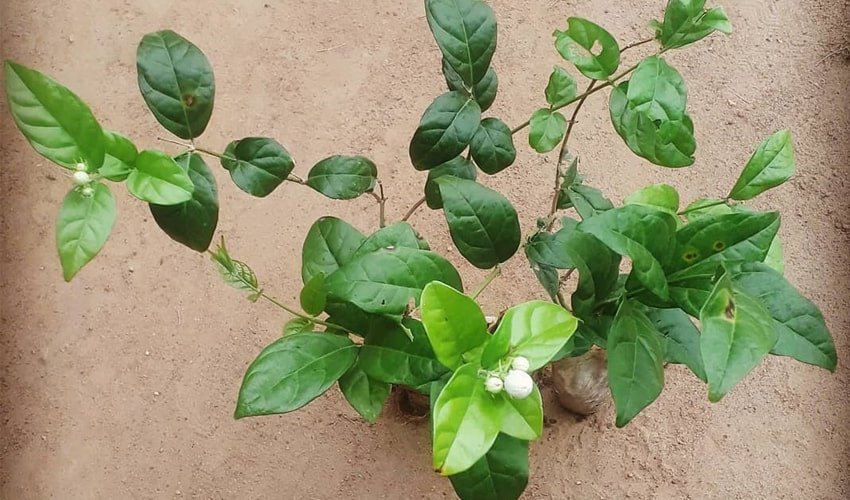
Best time to plant jasmine
Plant jasmine shrub any time between June and November. A few Chameli is suited to continuous open-air living, whereas other sorts have to come into the house over winter.
Cases of solid Jasmine that can stay outside year-round incorporate Stephanor pink jasmine (Jasminum × stephanense), which pulls in hummingbirds, developing to almost 13 feet tall.
Italian Jasmine (Jasminum humile) bears butter-yellow blooms, winter jasmine (Jasminum nudiflorum) that blooms in January, and white Jasmine that has white blooms showing up between June and Admirable.
Delicate jasmines require temperatures over 40 degrees Fahrenheit to flourish. In case you live in a zone where temperatures plunge lower than this in winter, you’ll get to develop the Chameli in pots for simple transport inside.
Put the pot in a shining, sunny window and keep the soil equitably damp until any risk of lower temperatures passes.
Cases of delicate jasmines incorporate South African Jasmine (Jasminum angular) with white, scented blooms and angel wing Jasmine (Jasminum nitride), which bears dark pink flowers.
Where to plant Chameli?
Choose a warm, sheltered location when growing Chameli. The pot estimate ought to be 12 inches, both more extensive and profundity with seepage gaps at the foot. The seedlings may create inside 2 weeks, and you’ll be able to begin watering in little sums.
Water Chameli plant from the foot to keep the soil damp but not wet. Make sure that which flower pot you choose has drainage holes to avoid overwatering the plant.
Soils that Jasmine thrive in
Soils that Jasmine thrives in – Jasmine needs well-drained but moist, moderately fertile sandy loamy soil. Install the plant in the ground at the equal level it was growing in the nursery pot. Most Chameli plants were grafted onto the common jasmine rootstock because of it was superior hardiness.
How much sun does Jasmine need
Jasmine needs full sunlight or portion shade – ordinarily almost 6 hours or more of coordinate daylight each day for full sun, and 2 – 4 hours per day for halfway shade. The precise sort of Chameli you plant will decide how much sun a plant requires in expansion to climate and other conditions.
Supports for Chameli plant
Supports for Jasmine – If planting a twining vine variety and wanting Jasmine to climb, the plant will need a support structure. A trellis or fence both work. Chameli plants need well-draining and moderately fertile soil.
The soil that your Jasmine plant should be planted in varies quite a bit supports can serve as curiously central focuses within the plant or give a sense of walled in the area by screening sees and/or depicting boundaries (wall, trellis boards, dividers, pergolas).
Space required by Chameli plant
Jasmine ought to be planted at the slightest 8 feet, now more depending on assortment, separated to suit its future root development because it will develop massively and does not like to be swarmed.
Different varieties are planted in different spaces. It requires spacing of a different Space required for different varieties; for mogra, it requires 75cm x 1m or 1.2m x 1.2m or 2m x 2m.
How deep the plant
Burrow a gap for the Jasmine that’s fairly profound sufficient so the plant will rest at the same level within the ground because it was when it was within the pot. It doesn’t have to be planted in a profound gap. The starter plant has been grown in a 2-3″ deep in the pot.
Where does chameli grow?
Jasmine is developed in France, Spain, Italy, and a few North African and Centre Eastern nations. The detailed life zone for Jasminum officinal is 11 to 27 degrees centigrade with a yearly precipitation of 0.3 to 2.8 meters and a soil pH of 4.9 to 8.3.
How much water does this plant need
Water – Jasmine plants require a lot of water, particularly when they are in blossom. It is best to keep the soil somewhat damp continuously. The plants ought to be watered on a week-by-week premise, but if the soil gets to be dry sometime recently, water the plant early.
Growing Chameli Plant
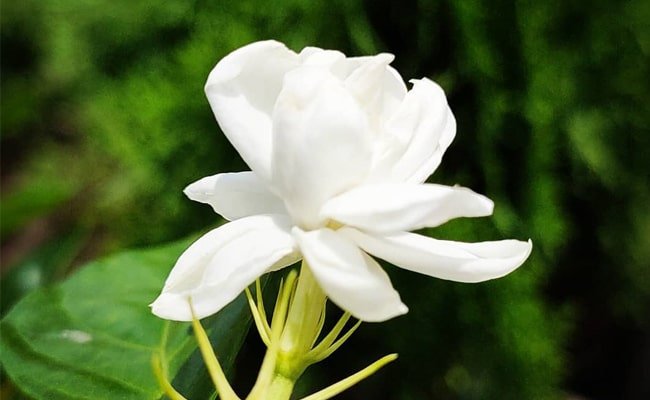
To plant Jasmine is to purchase a youthful jasmine plant; it is additionally conceivable to begin Jasmine from seed. Chameli seeds have a moo germination rate and require extraordinary care concurring to the cultivar.
In most cases, you’ll begin the seeds inside in seed pots filled with seed starter blend; at that point, solidify off the seedlings and plant them exterior once the final ice has passed. Another way to plant Chameli is to utilize semi-ripe cuttings taken from a developed jasmine plant.
While the foremost common way Slide the jasmine plant tenderly from its holder and water the root ball. Tickle the roots by delicately scratching them all over.
Burrow a gap twice the estimate of the root ball and set the Chameli plant interior. Take off the soil around the gap a small taller than the soil level of your plant, making a supply for water.
Softly pat the soil around the base of the jasmine plant to hold its input. Water the soil around the base well to assist the plant settle. Include more soil in case vital to keep the Chameli erect.
Jasmine can develop both inside and outside. Overshadow assortments do best inside, but vines can too flourish interior the domestic. Fair squeeze or prune the plant within the dormant season to preserve the specified stature and shape.
How to care for the Jasmine plant?
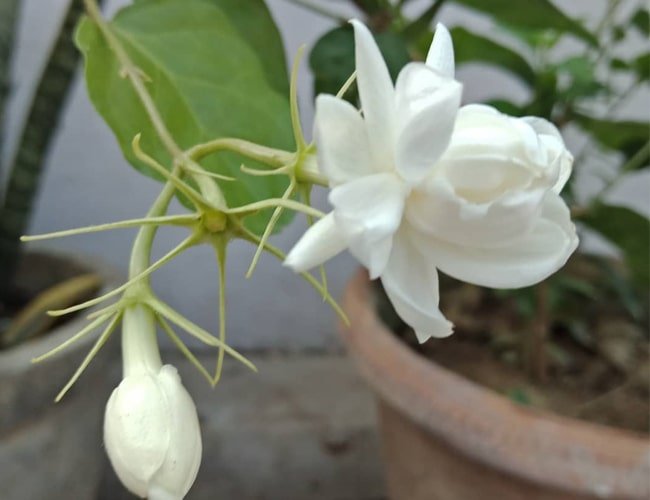
Watering
(In Winter)
Jasmine plants rest amid the colder months and continue development within the spring. Without the ought-to-back sprouting, they do not require as much water within the winter.
The dampness doesn’t vanish out of the soil as rapidly, either. This plant implies you don’t get to water about as regularly — in stormy or damp winters, you might not have to be water open-air Chameli at all.
Check the soil almost once a week to see if it feels dry 1/2 inch underneath the surface, which shows the plant needs a little water.
(In summer)
Within the warmth of the summer, you might water your Jasmine each two to three days or whenever the top 1/2 inch of soil feels dry. Feeling the soil is the most excellent pointer; a few soils hold water way better than others, so you regularly got to water less frequently with these.
If you’re having a blustery summer, you might supplement as it were once in a while.
Chameli needs at least six hours of daylight per day to bloom legitimately, but plants that get coordinated sun all day might require more water. With all these factors, there’s no set plan for watering your Jasmine.
Fair jab your finger within the soil at the base of the plant each couple of days to see on the off chance that it feels dry 1/2 inch underneath the surface; if so, it’s time to water.
Training
When planting a modern jasmine vine, put it exceptionally close to the trellis base or anything component you may be utilized as a climbing structure. Utilize plastic zip ties, delicate cloth strips, or cultivate twine to affix the vine to the trellis.
On the other hand, you’ll be able to weave the vine and its offshoots through the gaps within the trellis as they grow. Another methodology for preparing Chameli on a trellis or fence is to let the most vine develop on a level plane at the base. Secure it with ties to the base of the structure.
At that point, as blossoming offshoots grow, you’ll tie them to the structure so that they run up vertically and cover the surface. You will trim your vine more than once a year as the plant develops rapidly.
The most excellent time to trim is in late winter; sometimes recently, the developing season starts. You’ll be able to cut it back by as much as one-third to preserve a clean appearance and energize modern growth.
Amount of Sunlight
Jasmine flower needs high sunlight. Jasmine needs portion shade – as a rule, around 6 hours or more of coordinate daylight each day for full sun and 2 – 4 hours per day for fractional shade.
The precise sort of Jasmine you plant will decide how much sun a plant needs in expansion to climate and other conditions.
Tips on how to prune
When youthful plants start to put out modern development, begin squeezing out the best half-inch (1.3 cm.) of the stems by crushing them between your thumbnail and finger. Squeezing the tips, particularly within the beginning with two a long time, advances quick development and lavish foliage.
Squeeze sidelong stems as well as the most upright stem. Expel tangled stems and ancient stems that now do not deliver blooms. Keeping the vine free of masses of tangles progresses the appearance and makes it less demanding to require care.
In case you experience a difficult tangle, remove the stem in areas instead of attempting to snap it free….
Abbreviate stems to keep the vine inside the bounds of the trellis or arbor. Remove any dead, harmed or ailing stems. This plant will keep the vine looking flawless and anticipate the spread of illness.
Expel stems that are developing absent from the supporting structure. You’ll control the heading of modern development by pruning fair over a leaf stem
that’s developing within the heading in which you need the vine to develop.
Propagation
Make the cuttings about 6 inches long (15 cm.), and cut each one directly below a leaf. Strip the leaves from the bottom part of the cutting and dip them in rooting hormone powder. Place each cutting into a hole in damp sand in a planter, and place the planter in a plastic bag to hold moisture.
Winter care
You would like to supply a layer of natural mulch to the roots of the Jasmine in winter. Utilize up to 6 inches (15 cm.) of straw or 3 to 4 inches (8-10 cm.) of destroyed hardwood for winterizing jasmine plants.
Fallen takes off moreover make great winter mulch, and they work indeed superior if you shred them to around the measure of a quarter sometime recently spreading them over the roots.
In case the stems start to kick the bucket back, you’ll be able to cut them down as moo as 6 inches (15 cm.) over the ground.
To keep Chameli plants over winter exterior their appraised zone, you would like to bring them inside. Developing them in pots makes moving the plants inside for winter much less demanding.
Indeed so, dry indoor discussion and insufficient daylight may cause the plants to lose their takes off, and they may indeed kick the bucket.
Whereas they are inside, provide the plant’s typical room temperatures amid the day with cool temperatures at night. This plant permits them to rest over winter.
Also Read: 35 Indoor Plants Ideal for Every home Or Apartment
Protect against pests and disease
First, combating any illness is to disconnect influenced plants.
Second requires the evacuation of harmed and ailing plant parts. This plant incorporates picking up dropped takes off. Within the case of pruned plants, introducing the Jasmine in a clean, sanitized pot with new soil will regularly anticipate assisting contagious spores from harming the takes off.
At that point, take after appropriate water and social hones to anticipate common infections in Jasmine.
Plants are a bit more difficult in the ground, but you’ll be able to burrow around the plant and put in new soil or evacuate it and wash off the roots and replant it in a recently revised location.
Utilize Neem oil showers for any creepy crawly issues, fungicides or a blend of heating pop and water to combat parasites and redress social care to advance the plant’s wellbeing and offer assistance it recoups its beauty.
Types of Chameli plants
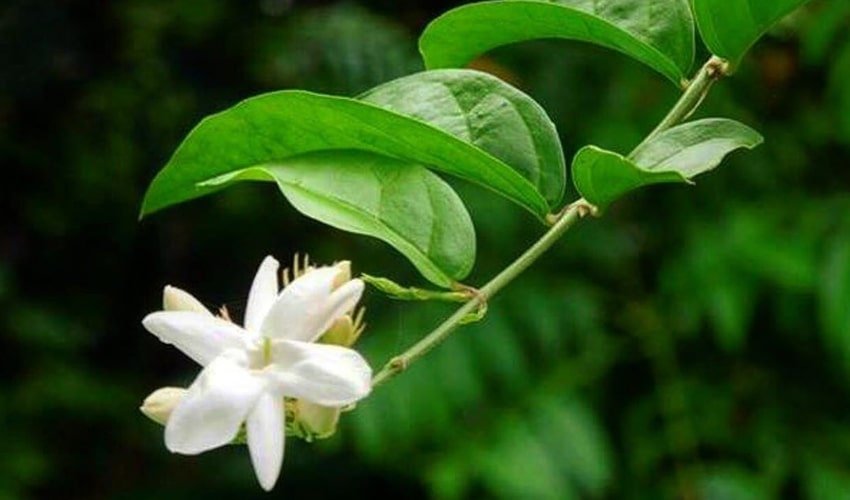
There are about 200 species of Jasmine. In this article, we list out some types of Jasmine.
1. Common Jasmine (Jasminum officinale)
Jasminum officinal (Common Jasmine) could be a large semi-evergreen or deciduous climbing bush that nursery workers revere for its energetic propensity, agile see, and wonderful scent. It produces a huge flush of bountiful clusters of 3-5 fragrant blooms in late spring or early summer.
2. Angel Wing Jasmine
An appealing, spreading, shrubby, vine-like groundcover shows an abundance of expansive, fragrant, pinwheel-like white blossoms with purple undersides. A great blooming evergreen for spilling out of holders or utilizing as a spreading filler between bush.
3. Royal Jasmine (Jasminum grandiflorum)
Moreover, Jasminum Grandiflorum, known differently as the Spanish Jasmine, Regal jasmine, Catalan jasmine, could be a species of Jasmine local to South Asia, the Middle eastern promontory, East and Northeast Africa and the Yunnan and Sichuan districts of China.
4. Dwarf Jasmine (Jasminum Parkeri)
The Dwarf jasmine is species of plant within the family Oleaceae. It may be a domed evergreen bush, developing to approximately one foot in tallness, which bears a tangled bunch of little stems with little oval leaves.
5. Pink Jasmine (Jasminum polyanthum)
Award-winner Jasminum Polyanthum (Pink Jasmine) may be a strong-growing evergreen vine with masses of heightening fragrant, long-tubed, white blossoms, 1 in. over (2 cm), opening from pink buds. The blossoms Born in thick clusters are white interior and rose-coloured exterior.
Pink Jasmine may be a blooming plant within the olive family Oleaceae, local to China and Myanmar. A solid evergreen twining climber is particularly famous for its plenteous, exceedingly fragrant pink to white blooms.
6. Winter Jasmine (Jasminum Nudiflorum)
This winter, Jasmine could be a slim, deciduous bush local to China (Gansu, Shaanxi, Sichuan, Xizang (Tibet), Yunnan). The flower’s blooming crests right after winter, which is why it is additionally named Yingchun (迎春) in Chinese, which implies “the blossom that invites Spring.”
7. Indian Jasmine (Jasminum Multiflorum)
Jasminum Multiflorum could be genuine Jasmine with 8 lobed white blossoms and is exceptionally fragrant. The star-formed blooms can now cover the whole plant, clearing out exceptionally few clear obvious. It is an evergreen, branching vine prepared as a bush or as a spreading, vine-like bush.
8. Star jasmine
Star jasmine (Trachelospermum Jasminoides) could be a vine that produces exceedingly fragrant, white blooms that draw in bees. Local to China and Japan, it does exceptionally well in California and the southern U.S., where it gives great ground cover and climbing enrichment.
9. Cestrum Nocturnum (Night-Blooming Jasmine)
Night blossoming jessamine, or lady-of-the-night (Cestrum nocturnum), isn’t genuine Jasmine at all but could be a jessamine plant of individuals of the nightshade (Solanaceae) family in conjunction with tomatoes and peppers.
Jessamine plants are frequently alluded to as jasmines since of their profoundly fragrant blossoms. As a result, their names are so comparative. Like Jasmine, jessamine plants can be bushes or vines.
Night sprouting jessamine may be a tropical evergreen bush. Night sprouting jasmine develops 8-10 feet (2-3 m.) tall and 3 feet (91 cm.)
10. Arabian jasmine
Arabian Jasmine is a species of Jasmine native to tropical Asia, from the Indian subcontinent to Southeast Asia. It is cultivated in many places, especially across much of South and Southeast Asia.
It has naturalized in many scattered locales: Mauritius, Madagascar, the Maldives, Christmas Island, Chiapas, Central America, southern Florida, the Bahamas, Cuba, Hispaniola, Jamaica, Puerto Rico, and the Lesser Antilles.
Interesting facts about Jasmine plant
- Blooming happens amid the summer or spring.
- Its scent is frequently discharged amid the night.
- Jasmine, more often than not, bears white flowers.
- It isn’t noxious, despite the reality, numerous individuals accept so.
- From Jasmine’s flower, you’ll be able to make medicines. Jasmines develop well in wet, well-drained, sandy soil to clayey plant soil.
- Jasmine can live from 15 up to 20 a long time within the wild.
- The blossoms are regularly around 2.5 cm.
- Sometimes its blooms can be yellow.
- Jasmine contains both regenerative organs.
- The primary Jasmine’s pollinators are the bees and the butterflies.
- Jasmine’s natural products are berries.
Common Problems That Chameli Plants Experience
There are a couple of techniques for jasmine fertilization. Plants rarely need extra nutrients applied to the soil in a rich organic growing medium. Applying compost to the top of a container once or twice a year can help sustain the container with a safe and nutritious amount of organic material.
If you want to use chemical fertilizers on the Jasmine grown in your jar, too much of a good thing will indeed occur with plants.
A notice on chemical fertilizer salts and fertilizer salts is significant. If they are in poor soil, plants in the soil will also benefit from additional food added at the right time.
Either change the soil with mulch or organic mixtures or use a slow-release granular or liquid dilution of jasmine plant fertilizer in spring when it is jasmine fertilizing season.
Before choosing a process, evaluate your soil, the condition of the plant and its location.
People’s question related to jasmine plant
1. Is jasmine an annual or perennial?
Perennial
2. How long does it take to grow jasmine?
4 to 6 months
3. When is the best time to plant jasmine?
June to November
4 . Do jasmines spread?
Yes, 1.5 to 2 feet tall and 4 to 5 feet wide.
5. Can jasmine grow in full sun?
Yes , more than 5 hours
Have some questions Or suggestions? Use our comments section on this blog! You can feel free to leave a comment or two down below, and we’ll get back to you as soon as possible!
We love reading your messages……

